In previous Parts of this series we looked at the arguments of those who deny the demographic changes created by mass migration (Part 2), of those who accept the demographic changes, but welcome them because they result in more “diversity” (Part 3), and of those who also accept the demographic changes and welcome them because of the supposedly high education level and the job skills of the immigrants (Part 4).
In the current Part we shall look at the arguments of supporters of mass migration as related to crime by refugees and confront these arguments with evidence.
Denying refugee criminality
Migration has caused concern for a long time among people in Europe. These concerns grew substantially since 2015, when German chancellor Angela Merkel opened the German borders for more than a million refugees, mainly from the Middle East.
One of these concerns is a growing sense of insecurity: many people feel less safe than a few years ago.
Supporters of mass migration in Germany, in particular in politics and in the media, typically dispute that these feelings of insecurity have a basis in reality. They ridicule people who express such feelings as having “diffused fears” or suffering from phobias like “xenophobia” and “islamophobia”. The following quotation is from an article in Zeit, one of the biggest and most prestigious weekly magazines in Germany, from 2016:
Help! Refugees!
Whether glyphosate, burglaries or foreigners: politicians stir up diffused fears to win voters. A successful scam, and ignorant people like to overreact to it.
The article then continues:
A glance at the statistics, however, shows: If you look at the current crime statistics, you will not find a single indication of an overrepresentation of foreigners in serious crimes; certainly not of refugees. Not even with rape. What is even more striking: Especially the numbers of fear-causing crimes such as personal injury, murder or manslaughter have been going back in Germany continuously.
This sounds a bit too good to be true, so let’s take a look at the statistics.
A glance at the statistics
The source of our “glance at the statistics” will be the report Crime in the context of immigration. Federal situation picture 2018 , compiled by the German Federal Crime Bureau (Bundeskriminalamt, BKA). Note: all statistical data about crimes, suspects, etc. in this report refers to resolved, cleared up crimes.
According to the report, from the beginning of 2014 until the end of 2018, a total of around 1,760,013 refugees were registered (p. 3 of the report). The report refers to this group of persons when it analyses the criminality of refugees. Given that the German population in 2018 was about 83.02 million, the proportion of these refugees was around 2.1%.
Crime suspects
Altogether, there were 1,931,079 crime suspects in Germany in 2018. Out of this total 30.5% were foreigners in general (refugees and others). The share of refugees on the total was 165,769, or 8.6% . This was slightly less than in 2017 (167,268). But because the number of all crime suspects slightly decreased since 2017, the share of asylum seeker suspects actually increased (from 8.5% in 2017, to 8.6% in 2018). See the chart below.
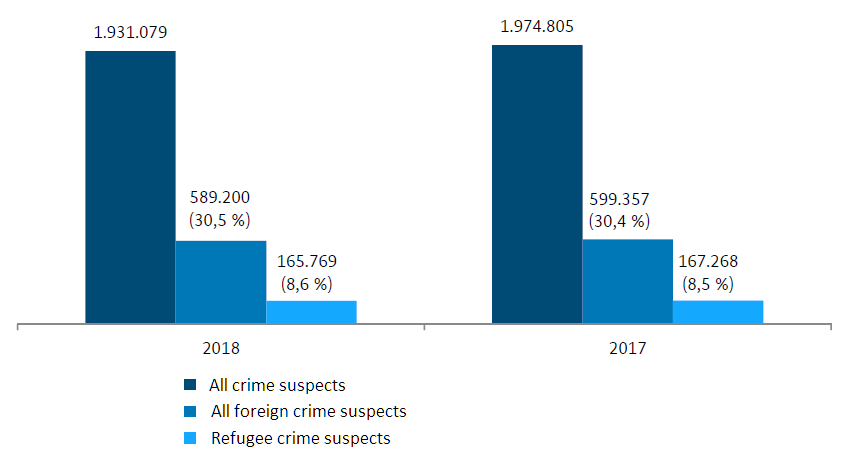
Source: Crime in the context of immigration. Federal situation picture 2018 , p. 7
Thus, the share of refugees on crime suspects was 4.1 times their share on the population in general. Note that 33% of the asylum seeker suspects were suspected of having been involved in multiple crimes. For example, 27.2% were suspected of 2 to 5 crimes and 3.8% were suspected of 6 to 10 crimes.
Refugees were particularly over-represented in violent crimes in 2018. 9.9% of suspects in “crimes of gross misconduct and criminal offences against personal freedom”, 12.4% of suspects in sexual crimes and 14.8% of the suspects in “crimes against life” were refugees (pages 27, 22 and 18 of the report). Thus, in these crime categories their share was about 5 to 7 times their share in the general population.
Comparing the number of all refugees who arrived in Germany between 2014 and 2018 with the number of crime suspects among them, one finds that about 9.4% of all refugees were suspected of some crime, and one third of those of multiple crimes. In comparison, about 1.6% of German citizens were crime suspects in 2018.
Note, in addition, that our focus here was on the refugees. If one wants to assess the effect that mass migration has on crime levels, one should consider all foreigners, too. This group includes the refugees but other foreigners as well, and consists of about 9.9 million people, that is, about 12% of the whole population. They, however, cause about 30.4% of all crimes, which means that their share in the crime statistics is about 2.5 times their share in the population.
The 9.9. million foreigners belong to the group of the “people with migration background”. This group consists of about 20.8 million people, or about 25% of the German population. The rest of the “people with migration background” – about 10.9 million people – are German citizens, either born in a foreign country, or children of people who were born in a foreign country. This group doesn’t seem to appear anywhere as a separate group in the crime statistics, but there are reasons to assume that they also have a higher share in crime than their share in the population.
Resolved crimes
The chart below shows the development of the number of all resolved crimes in Germany, between 2014 and 2018.
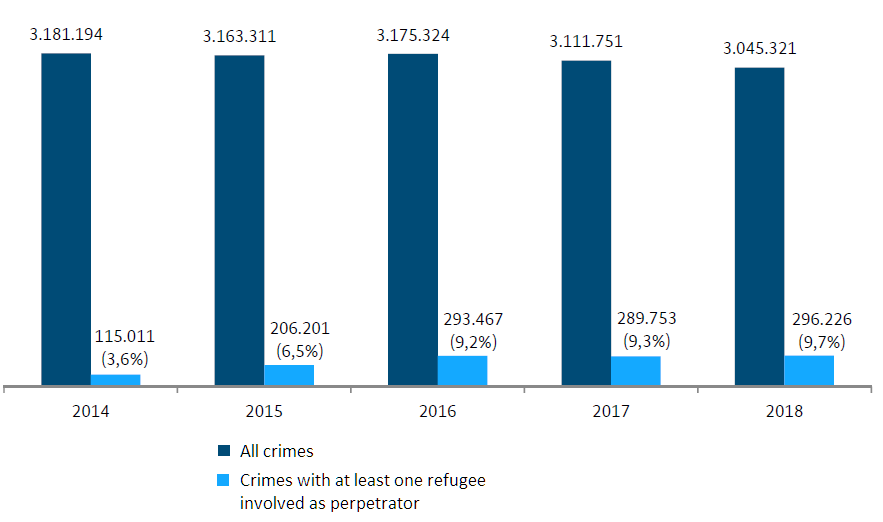
Source: Crime in the context of immigration. Federal situation picture 2018 , p. 15
The chart also shows that the number of all crimes did decrease slightly – by 2.1% – between 2014 and 2018. The percentage of crimes committed by refugees, however, increased from 3.6% to 9.7%.
Thus, almost 10% of all resolved crimes – almost 300,000 – in 2018 were committed by people who received protection and generous support from Germany because their lives were supposedly threatened in their home countries. (Note : during the same time period – in particular during 2015 and 2016 – the absolute number of refugees also increased a lot).
So much about the claims in the Zeit article quoted above, regarding the number of crimes committed by refugees. In defense of Zeit magazine which published the article quoted above, one should mention that this article full of lies was an opinion piece.
New types of crime – a result of mass migration
New types of crime have appeared recently in Europe, some of them never seen in Germany and Europe before. All are connected to mass migration. Here is a sample of these.
The type of crime which maybe causes the most horror in Europeans is Islamic terror attacks. There have been dozens of such terror attacks since the year 2000 in Europe, resulting in several hundreds of deaths and even more injured. The following picture shows the number of Islamic terror attacks in Europe since 2000.
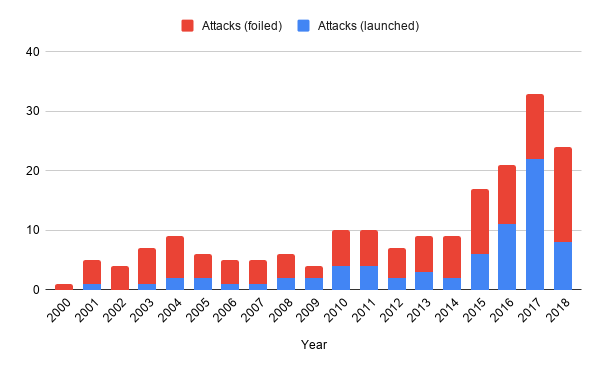
Source: Politico article on Islamic terror in Europe and
Europol reports on Terrorism
There has been a sudden, large increase in the number of Islamic terror attacks in 2015, reaching a peak in 2017.
The Islamic terror attacks were committed either by new migrants or by Muslims resident in Europe. The Wikipedia article about Islamic terrorism in Europe writes:
According to a 2017 interview with Islamism expert Lorenzo G. Vidino in the aftermath of the 2017 Barcelona attacks, jihadi terrorists in Europe mobilized by ISIL have tended to be second-generation immigrant Muslims.
Many terror attacks could be foiled because of the vigilance of the Police. Keeping up this vigilance requires lots of police resources. In Germany, for example, according to the Federal Crime Bureau (BKA), there are currently about 702 Islamic “endangerers” (people who can be expected to commit a serious crime, like a terror attack) and about 512 “relevant persons” (potential supporters of terrorism). In addition, there are about 11,800 radical salafist Muslims.
A type of crime often reported about in the German media is the organized crime of Lebanese “crime families”. These people are the descendants of Kurdish and Palestinian refugees fleeing the Lebanese civil war in the 1980s. They are involved, for example, in drug trafficking, protection rackets, prostitution, robberies and burglaries. They are also conspicuous for
disrespect and considerable potential for aggression, which can escalate into violent attacks on police officers
Many clan members are young, with very little education. They often appear in large groups
to demonstrate their strength … [T]he nature of the appearance of the clan members in the public depends on the size of their own group and the numerical strength of the police officers deployed. The larger the own group and the smaller the number of police forces, the more aggressively the clan members act.
One particularly worrying development is that
Kurdish-Lebanese clans are increasingly trying to infiltrate immigration offices, admissions offices or job centers and to use bribes to influence public administration.
Another disturbing new type of crime is the mass sexual molestation and violation of women. This type of crime was imported from the Arabic Middle East, where it is called “taharrush gamea”. CBS reporter Lara Logan had the bad luck to experience it on her own body in 2011, at the Tahrir Square protests against the dictatorial system of President Mubarak in Cairo, Egypt.
In Germany “taharrush gamea” appeared on the scene the first time during New Years Eve 2015 in Cologne and in other cities. Large groups of men of migrant background surrounded individual women, sexually violated them and often robbed them of valuables.
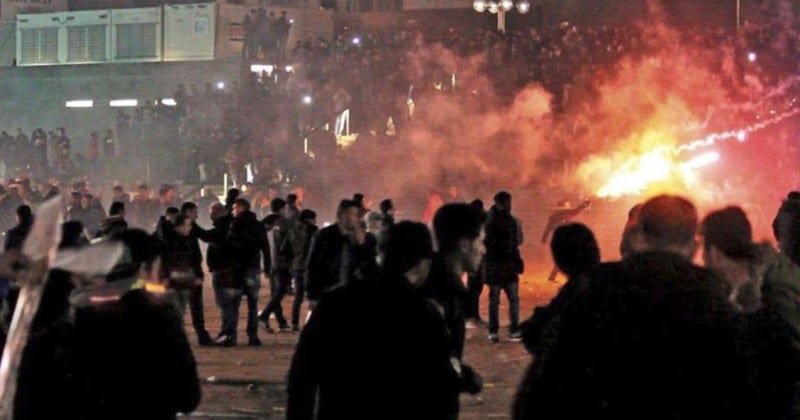
A large increase in knife crimes was also seen, some of them with deadly outcome. One kind of these knife crimes particularly upset the German population: asylum seekers from Middle Eastern countries start a relationship with young German women. When these women decide to stop the relationship, some of these men react with such anger that they stab the woman to death. The case in Kandel, in 2017 was typical: Abdul Dawodzai, a supposedly under-age Afghan refugee stabbed Mia Valentin, a 15 year old girl, to death when she refused to continue their relationship.
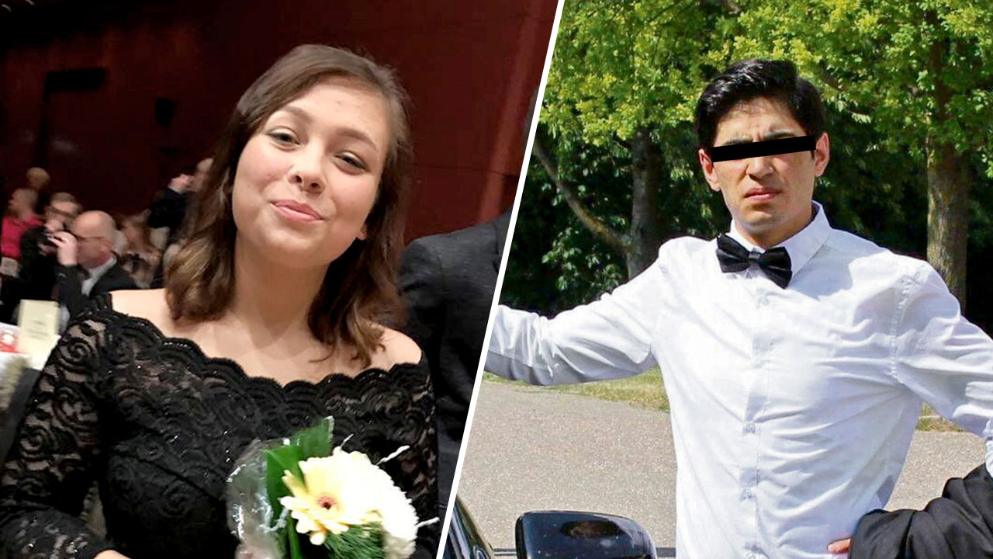
There is so much fear about knife attacks in Germany that in April 2019 Illu der Frau, a German women’s magazine published an article with the title “How do I treat a stab wound?”. The sub-title of the article below says:
Again and again, one hears about reports of attacks with knives …
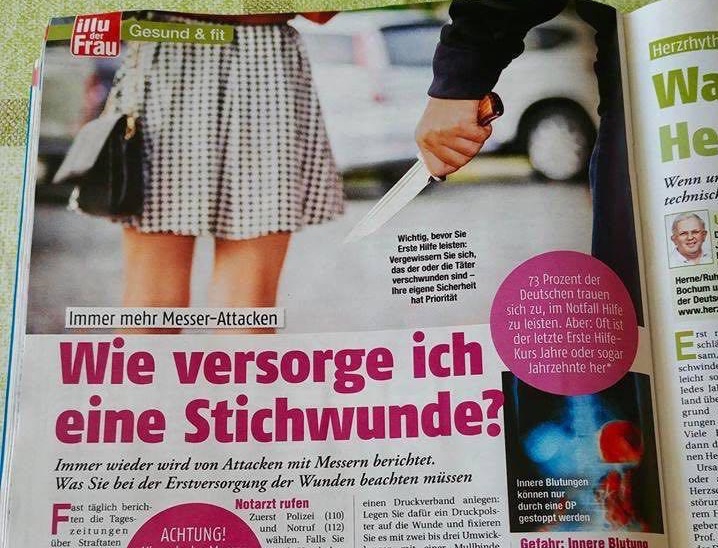
In the summer of 2019 there has been increased violence in German swimming pools. Groups of young migrants attack and fight with each other and with security personnel. In the German city Essen they attacked two pool supervisors, fled only when a third one came to help, and beat a 12 year old girl while running away. Similar has been the situation in an open air swimming pool of the city Düsseldorf. On 29. July 2019 the German Magazine Die Welt wrote this:
It was the third time in four weeks that the open air swimming pool had to be cleared due to riots by swimmers. A group of young men had taken the diving board and slide and did not let other guests through. The lifeguards could not prevail. Police was alarmed and sent in the summer heat about 1500 visitors from the swimming pool and from the meadows home.
The “young men” in the article is a code word that everyone in Germany understands: in context of violent or unruly behavior it refers to young Muslim men.
The reaction of the police was quite typical: instead of removing or arresting the few dozens of trouble makers, they instead evacuated the swimming pool. The mayor of the Düsseldorf acknowledged at a press conference that “part” of the 20 to 60 “youth” were visibly of North African origin.
During the last few years swimming pools have also been frequently the scene for sexual harassment. As a result, many swimming pools now have posters on their walls, warning about unacceptable behavior like grabbing women, not obeying female pool personnel and disrespect towards women not dressed in a modest way:
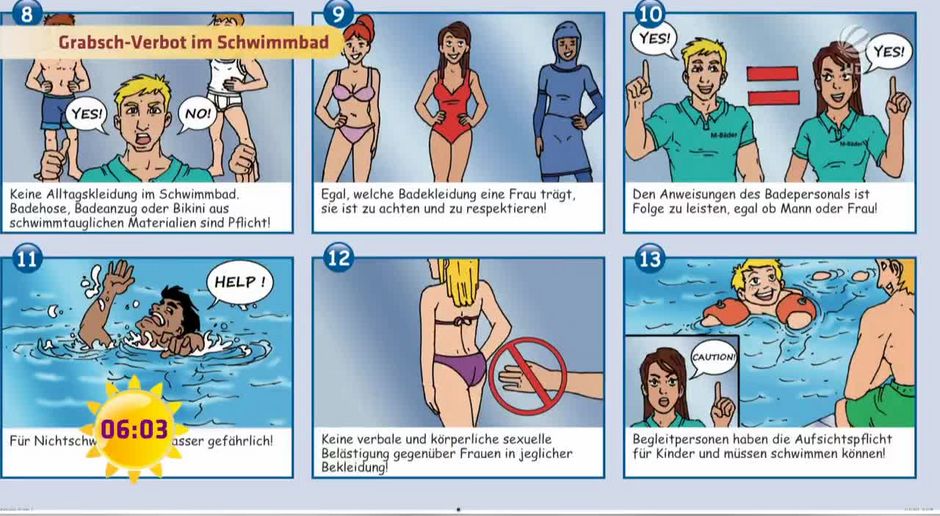
Another novel type of violent crime is pushing people onto train tracks, sometimes in front of oncoming trains. This happened several times 2019, for example in Essen and Dortmund. In July 2019, in Voerde and in Frankfurt two people were killed in this way. In both cases the suspects were migrants, one of them from Kosovo and the other one from Eritrea. The following picture shows the interactive map of recent cases of people pushed on train tracks.

Antisemitic hate crimes
Antisemitic hate crimes also increased, to a large extent due to the influx of Muslims from virulently antisemitic Middle-Eastern countries. In many German schools “You Jew” became a curse word and Jewish children in schools are mobbed by Muslim children, as at a Berlin primary school in Berlin:
At the Tempelhofer Paul Simmel primary school, a second grader [Jewish girl] was cursed by a Muslim classmate as a Jew. A classmate is said to have threatened to kill her because she does not believe in Allah.
According to the school, 70 % of the students have a migration background.
The video below caused outrage in Germany in April 2018. Two Israeli boys, wearing kippas were attacked by a Syrian refugee who used a belt to beat one of them.
In July 2019, a rabbi in Berlin was cursed and spat at when walking on the street together with his children. The attackers were two Arabic-speaking men.
In May 2019 the Commissioner for Antisemitism of the Federal Government of Germany warned
Jews against wearing kippahs everywhere in Germany. “I can not recommend Jews to wear the Kippa anytime anywhere in Germany. Unfortunately I have to say so, ” Felix Klein told the newspapers of the Funke media group. He had “unfortunately changed his opinion as compared to earlier times”.
The statement of the Commissioner said that 90 % of the antisemitic incidents come from the radical Right, and the rest from Muslims living in Germany. There are justified doubts against this information. One reason for this doubt is the way the criminality statistics is composed in Germany:
If nothing specific has been identified about an antisemitic offense, it is classified to be committed by the Right, not by the Islamists …
If unknown people spray antisemitic slogans or attack a Jewish citizen, then a right-wing extremist background is suspected, although Islamists might as well be the perpetrators. In the summer of 2014, the police noted “Sieg Heil” calls from a demonstration of radical Muslims and assumed a far-right background.
In 2018, an online survey by the EU’s Fundamental Rights Agency FRA asked 16,395 Jews in twelve EU countries about their everyday experiences with antisemitism. The results, writes the German newspaper Jüdische Allgemeine,
show that hatred of Jews no longer predominantly comes from the right-wing edge of society. The most frequent categories of perpetrators were radical Muslims (30 percent), followed by people from the left political spectrum (21 percent), work or school colleagues (16 percent), people from the circle of acquaintances (15 percent) and only then people with right-wing views (13 percent).
“No-go zones” in Sweden
The issue of integration has been publicly debated for many years now. European states spend large sums of money on projects aiding integration, but many of these projects fail. The multicultural ideology followed by many European states has been identified as one of the reasons for the failing integration. As an article in the magazine Foreign Affairs states:
According to multiculturalism’s critics, Europe has allowed excessive immigration without demanding enough integration—a mismatch that has eroded social cohesion, undermined national identities, and degraded public trust.
Mass immigration – a large and constant influx of immigrants – tends to result in the build-up of ghetto-like areas where large numbers of migrants live among each other, hardly in contact with the surrounding European society. These areas can become crime-ridden “no-go” areas for police, fire-fighters and for ambulance. In Sweden, many politicians laughed at US President Donald Trump, when he, at a rally in 2017, implied – in a somewhat clumsy manner – the existence of large problems with immigration in Sweden.
They are not laughing any more. The situation in these areas has become so bad that barely one year after Trump’s comments, in January 2018, even the Swedish Prime Minister Stefan Löfven publicly considered deploying the army in some of these immigrant ghettos.
“Don’t go out alone for a jog” – in Sweden
There is a sad story of Swedish Police warning women about going out alone. In 2017, in the Southern Swedish city of Malmö, three teenage girls were gang raped on three different occasions. After the third – particularly brutal – gang rape of a 17 year old girl, in December 2017, Malmö Police gave a warning:
‘It’s about common sense. We are not warning people not to be outside, but to think twice and maybe not walk alone late at night and instead go with others or take a taxi,’ said Anders Nilsson of Malmo police who is leading the preliminary investigation.
This warning apparently upset a number of people who went onto the street to protest and demand police protection, tougher punishments for rapists and taking responsibility by the government.
This protest apparently made the police retract the warning a few days after it was issued:
Malmö police issued a formal statement retracting the officer Anders Nilsson’s remarks as being “unfortunate and unclear”.
Instead, now they advised
that the “public live their lives as usual” and “not to give in to fear”
This was a complete turn-around, a knee-jerk reaction: advising people to go on as before and to wait for the next rape to occur. The whole episode shows how helpless the Police itself feels about the situation.
The warning in Malmö by the police about women going out alone was not to be the last one: in August 2019, after four rapes occurred in the city of Uppsala, Police warned women not to walk alone in alleys and parks.
Apparently, neither the Malmö police nor the protesters have mentioned anything about who the perpetrators were or about the possible reasons for such brutal crimes in Sweden. If one can infer from the way these kinds of news are handled in German media, the description of the perpetrators in newspapers as “young men” is almost invariably a code word for “young Muslim immigrants”, understood as such by everybody.
Supporters of mass migration react to refugee crimes
Even supporters of mass migration are now forced to acknowledge that refugees do commit crimes – which some of them are even victims of. But then, they react to these crimes by applying a whole tool kit of obfuscations, deflections, relativizations and bagatellizations:
- These are “individual cases”, one should not “generalize”, this is nothing typical of the refugees, Europeans commit lots of crimes, too, etc.
- The perpetrator was under stress, “has gone through a lot”, lots of traumatic experiences, etc.
- Many of the crimes are actually misunderstandings: the criminal can’t help it, based on his culture he can’t help it but commit some types of crimes.
- The real problem is lack of opportunities for these refugees – and it is the Europeans who are really responsible: they didn’t provide enough opportunities for successful integration into society
Here are a few fairly typical cases from Europe, illustrating reactions to refugee crime by left-wing supporters of mass migration. Some of these reactions appear strange, almost surreal, but we think that all of them point to a common underlying dysfunction: a kind of suicidal empathy, tolerance and altruism, often combined with politically correct “virtue signalling”.
Deflecting the guilt from the migrants
If you expected that women would feel more solidarity with other women who have been sexually attacked, than with the attackers, you would be disappointed in the aftermath of the mass sexual attacks on New Years Eve 2015 in Cologne, Germany.
This event shook Germany to the core. Many commentaries about it have been written, among them by the two female journalists Dagmar Dehmer and Andrea Dernbach in an article which appeared in the major liberal German daily Tagesspiegel a few weeks after the events, in January 2015.
Right after admitting that most of the attackers were “probably” North Africans, the authors start a flood of deflections which continues until the end of their article.
These North Africans, they write, have been in Germany for some time, but they “don’t see a perspective” because “they know the basic structure of prejudice in German society”. This is the reason for their crimes.
The authors use the metaphor for the attackers as “hunters”. In the same sentence they call people who in the social media protested against the attacks “the right-wing mob, who rages on social networks on the Internet”, showing clearly where they see the real danger coming from.
Then, after stating that many women reported these attacks to the police, a sentence, which probably sounded bitter for many victims who might have read the article:
Perhaps there are also women who have not even been victims, but were of a political conviction that the perpetrators with a migrant background or the refugees who have exploited the chaos … for sexual assault, belong deported. Maybe they hope to accelerate this with their police report.
A nice suggestion that maybe some (how many?) women, who reported these crimes were lying, and that their only motivation for the police report was hate against refugees.
Then, a sympathetic report about a black journalist who is against sexism, but who, alas, is confronted with racism every day in Berlin, where he lives. According to him, these racists he encounters are not concerned about the women who were attacked in Cologne, they just want to prove that black and brown people are “animals”, and in fact hope that they do something like in Cologne, so that their prejudices can be confirmed.
Yes, the real problem are the racists – but not only them, the rest of German society, too:
This Rape Culture, which apparently marked Cologne’s New Year’s Eve, is also part of German culture.
This is followed by several long paragraphs, in which, almost until the end of the article, the German and European law systems and the lax prosecution of sexual abuse in Europe. For example, the usage of the word “abuse” in German law is decried, a word which is supposedly not clear enough in cases of sexual abuse.
At the very end of the long article by Ms Dehmer and Ms Dernbach, they manage to insert a criticism of “systematic sexual violence” in the Catholic Church, too.
The reader will be forgiven if he, after reading the article, is confused: what was that event in Cologne about? Did a racist mob commit some crime? Or was it German men who, grown up in a “rape culture” and unrestricted by lax German laws, abused large numbers of women? Or maybe some sex hungry members of the Catholic Church did that?
“An arm’s length distance“
After the New Year’s events Cologne’s left-wing Mayor Henriette Reker gave suggestions to women about how to behave in public:
There is always the possibility to keep a certain distance, which is longer than an arm’s length. So that one doesn’t try to get too near to a group of strangers to whom one doesn’t have much trust.
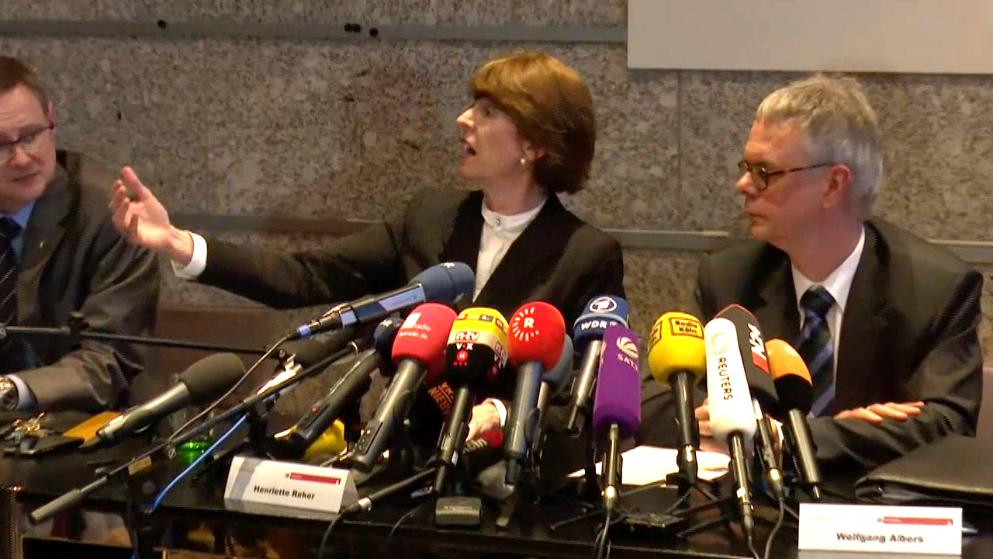
To some, this recommendation sounded like a way of blaming women, the victims of these crimes:
This well-intentioned recommendation, in the worst paternalistic tradition, has the unpleasant aftertaste that the victims are implicitly blamed for the crime. It recalls the unfortunate argument that she is partially guilty of the rape. Was the skirt too short? Was the walk too provocative? Did she not behave properly?
One wonders, how Frau Reker would have been able to even stretch out her arm in the massive crowd, shown in the picture below, which “celebrated” New Year in Cologne:
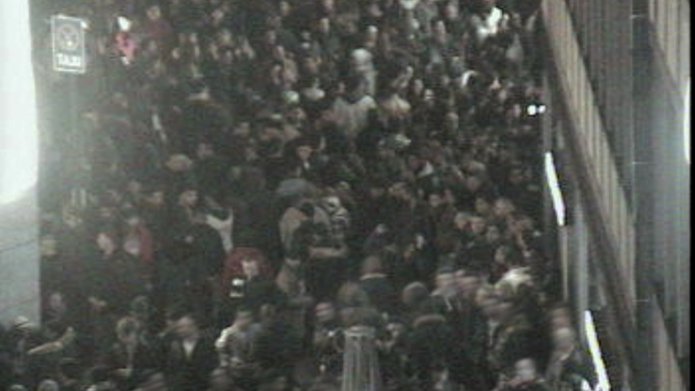
Feeling gratitude towards the criminal
If a migrant – whom you support and try to help – commits a crime against you, the most appropriate thing is not to feel disappointment about the lack of gratitude or even anger. Instead, you should feel gratitude, as suggested by Amelie Fried, a German author.
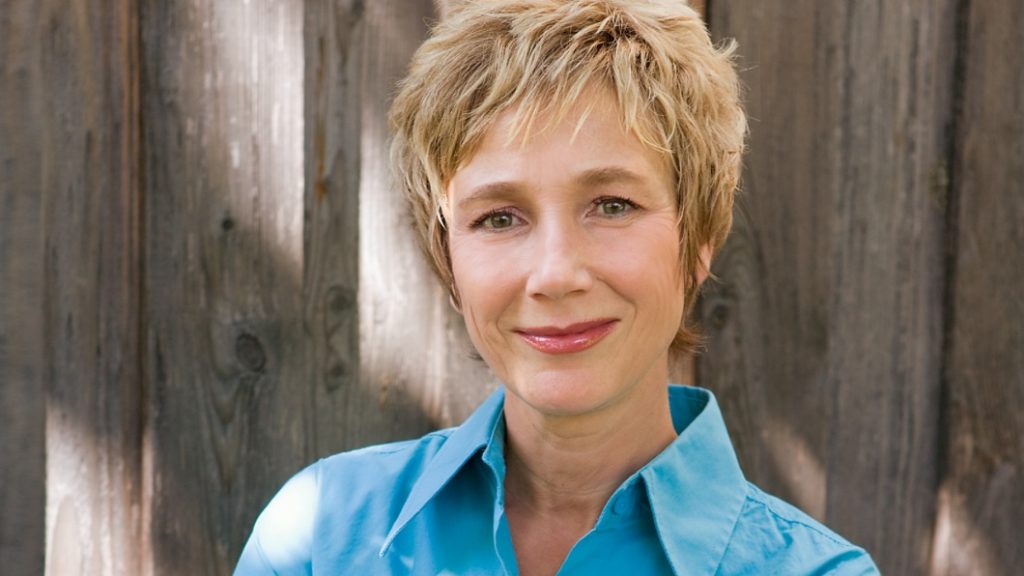
This is the story of her and of her stolen guitar, as described by Henryk Broder, another German author, in an article:
Amelie Fried, a successful writer, television presenter and, if necessary, a feminist, wrote in a short essay how years ago she and her family organized a Christmas party for unaccompanied minor refugees. There was gingerbread, fruit and sweets, and together they sang “Silent Night, Holy Night”. However: “At the end of the party our guitar was gone.”
Mrs. Fried remembers that she was at first “disappointed”, then “amused” and finally “ashamed”. How “for heaven’s sake” could she expect from “the young people that they should have been grateful”?It was exactly the other way around. “We had reason to be grateful to them. In one fell swoop, they re-adjusted the relations that had slipped away from us.” And: “We were glad that the guys kept our guitar. The lesson we learned was much more valuable than the instrument.”
Thanking anonymous male refugee for “being here” – after having been raped by other refugees
Selin Gören, a left-wing German politician of Turkish ancestry was raped in 2016, apparently by refugees (they spoke Arabic and Farsi). After the rape she stated to the police that she was robbed only and that some of the robbers were Germans.
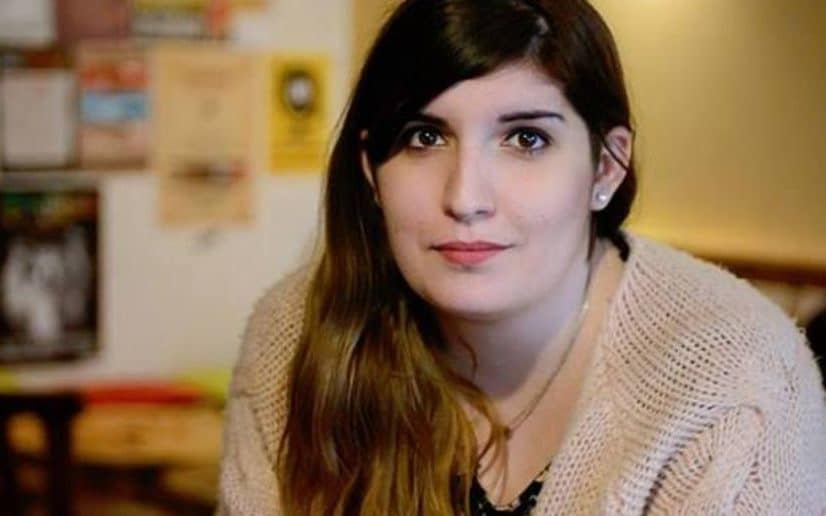
She said later in an interview:
I lied because I was afraid that the rape would be abused by law in order to fuel the incitement against refugees, which has risen dramatically just after the incidents in Cologne on New Year’s Eve. And I just did not want my story to give them another boost.
After a few days her boyfriend convinced her to go back to the police and tell the truth. As a result, she was blamed by other leftists to be a rightist traitor. She was so upset about this, that, to prove that she was still on the side of the refugees, published an open letter to male refugees on her Facebook site.
Unlike Amelie Fried, she does not directly thank the persons for the crime committed against her, but she does thank an anonymous “male refugee” for “being here” in a Facebook post which almost sounds like a love letter to male refugees. Here are excerpts from that post:
Dear male refugee,
probably at my age. Probably a few years younger. A little older.
I’m so terribly sorry!
…
I’m glad and happy that you made it here. That you left the IS and its war behind and did not drown in the Mediterranean. But I’m afraid you are not safe here.
…
For both of us, I am so incredibly sorry.
You are not safe because we live in a racist society.
I am not safe because we live in a sexist society.
But what I’m really sorry about is the fact that the sexist and cross-border acts that were done to me only contribute to your exposure to increasing and ever more aggressive racism.
I promise you, I will scream. I will not let it continue. I will not stand by and make it happen that racists and concerned citizens call you the problem.
You are not the problem. You are not a problem at all.
You’re usually a wonderful person who deserves to be safe and free just like everyone else.
Thank you for being here – and nice to see you there.
Thus, instead of naming the real perpetrators, she blamed a “sexist society” for her suffering in this Facebook post (which she deleted some time later). Also, apparently she didn’t see any need to apologize to Germans for putting the blame originally partially on Germans.
Feeling guilty because your rapist gets punished
When a migrant who has committed a serious crime against you has been caught and is punished, it is you who has reason to feel guilty. A case in Norway illustrates this:
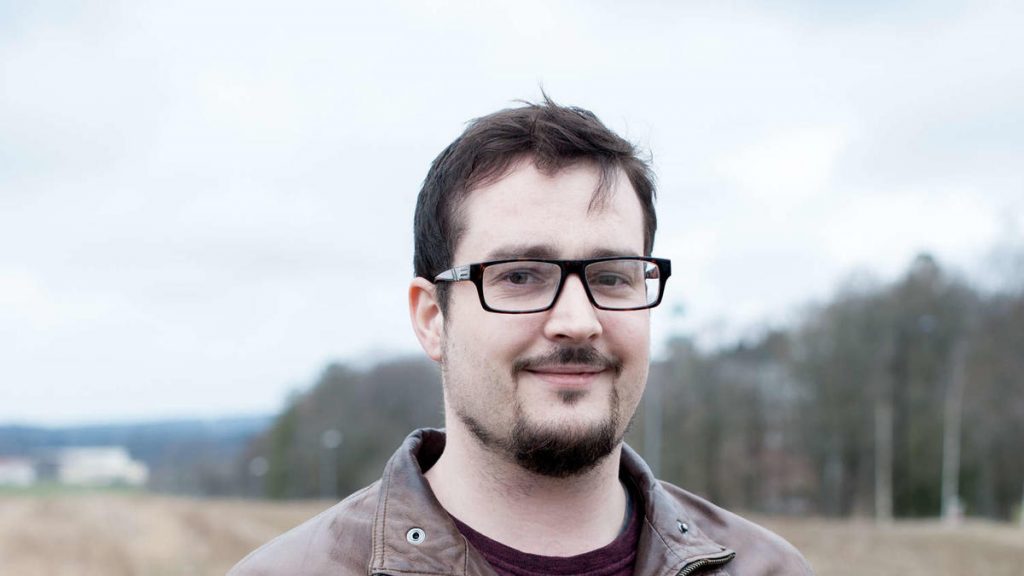
Karsten Nordal Hauken, who describes himself as a feminist and as an anti-racist, was sexually attacked [in 2011].
He said that although the incident caused a spiral of depression and substance abuse, he felt bad about the fact the man had been deported to Somalia when he had already served his prison sentence.
He said that … “[he] got a strong sense of guilt and responsibility. I was the reason why he should not be left in Norway, but rather to face a very uncertain future in Somalia …”
Protecting the molester of your daughter
In the cases mentioned above, the crimes affected only the people themselves who apologized for them, felt gratitude for them, etc. The following case went further: the victim was a teenage girl, abused by a refugee, whose mother tried to protect the abuser to prevent his deportation:
An Afghan migrant who molested a 12-year-old Swedish girl was initially not reported to police – because her mother was dating him.
Abdul Dostmohammadi, 18, was living with his 45-year-old girlfriend in Sölvesborg, southern Sweden, when he sexually molested the 12-year-old.
When the girl told her what had happened, the mother refused to report him to police as she feared he would be sent back to Afghanistan, court documents reveal.
The mother asked the daughter not to say anything about the incident, and Dostmohammadi continued living together with the mother and her daughter, until a few days later, when the girl told about the incident to her sister who told about it to her father, who then reported it to the police.
Islam is peace and love – claimed on the web site of a Christian church
Many of the refugees come from Africa and the Middle East. Most of them are Muslims. When they are involved in violent crimes, in particular in terrorism, the reaction by the establishment and the media contains one or more of these elements:
- We don’t understand
- Islam is peace, the perpetrators distort the message of a great religion, their crimes have nothing to do with Islam
- One should not generalize to all Muslims
- It is our fault: our Islamophobia, our attacks on Muslim countries, etc.
- The main victims are Muslims – they can expect a “backlash” after the attack
A page on the web site of the German Lutheran Church, evangelisch.de, is a good example of this apologizing attitude towards Islam. The page has the title:
Does the violence come from Islam? Ten claims and ten answers
Some examples of such claims and answers:
Claim 1: Islam is a violent religion
… the peacefulness of the religion of Islam can be justified theologically. Islam sees itself as a path of bliss: its ethics, with all the virtues known to us since antiquity, is to hold the middle measure, that between two extremes, excess and deficiency. Islam as a religion motivates Muslims to “make peace between people” (Qur’an 2,224). The Qur’an sees this as a guide and the Prophet Muhammad as a role model …
Claim 2: The Qur’an legitimizes assassinations and suicide bombings
The Qur’an sees itself as a decided declaration of love of God to all Mankind (Qur’an 5:54). In this sense, the Qur’an for Muslims is the revelation of God, who guides, carries, consoles, convinces and commits to the good, affirms life, appreciates diversity and otherness, and clearly rejects hatred and destruction …
Claim 8: The Koran calls for the humiliation and oppression of women
In the Koran, such a call can not be easily found. Women and men are equal …Claim 9: Muslims despise people of different beliefs and non-believers
… The Qur’an clearly states that Muslims should neither ignore those of other faiths nor those who do not believe in them, nor despise them, or convert them to Islam by force and under duress … At no point in the Koran is there any general verdict on the Jews and Christians.
The writer of the above piece is Ahmad Milad Karimi, Professor at the Center for Islamic Theology in Münster, Germany.
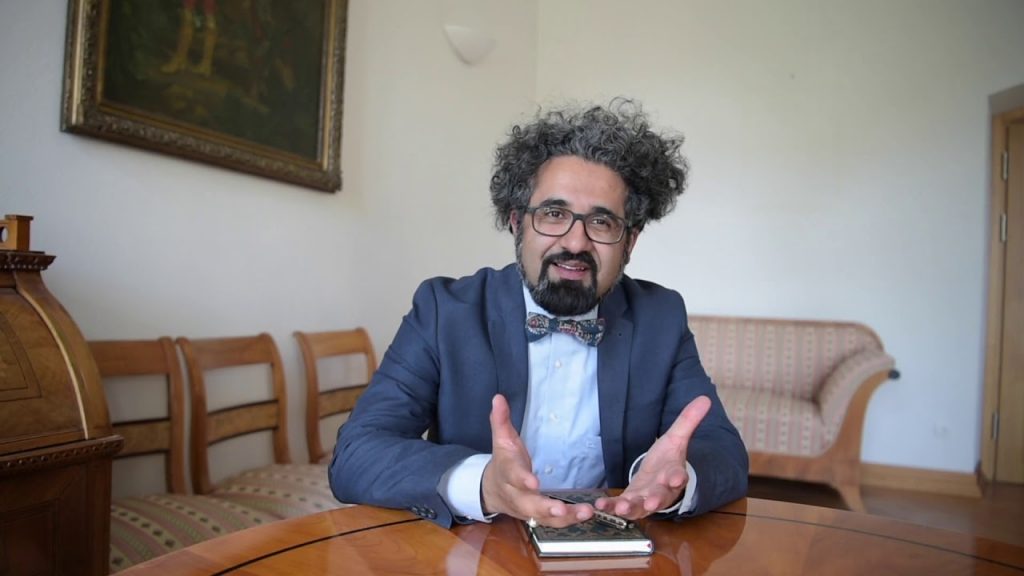
The editors of the Lutheran Church web site could have looked into the Qur’an – e.g. here where it describes how men should treat their wives if they become disobedient, here where it instructs about dividing the inheritance so that male inheritors receive twice as much as female inheritors, here where Allah threatens disbelievers with a curse, or here where disbelievers are called “the worst of creatures” – to see how diametrically opposed Professor Karimi’s piece is to what the Qur’an really says.
They could have had a glance, too, at the hundreds of misogynic, intolerant, violent places in the Qur’an documented, for example here, here and here.
Either they didn’t do any of this or they agree with Karimi’s description of the Qur’an. More probably, they prefer allowing their Christian audience to be deceived, for the greater good of appearing tolerant. In any case, Karimi’s piece has been on the web site of the Lutheran Church since August 2017.
Concern for Muslims – after an attack by Muslims
The Lindt cafe attack by Man Haron Monis, a Muslim radical turned terrorist in 2014 in Sydney, Australia, is a good example of the overriding concern some people have after an attack by Muslim terrorists – not for the victims of the attack, but for innocent Muslims. Such fear about a “backlash” seems to replace all anger about the attack and all concern for the actual victims of the terror attack.
While the attack in Sydney – in the course of which two people died – was still ongoing, the hashtag “I’ll ride with you” became viral. People made stickers with the text, which they wore, offering help to Muslims who might have had to fear attacks by non-Muslims.
As a gunman holds people hostage in a cafe in Sydney, thousands of messages of support have been posted online for Muslims in Australia who are afraid of an Islamophobic backlash.

Blaming the Police
How do supporters of mass migration react in cases when the Police acts against aggressive migrants to prevent a bad situation to become worse?
Blaming the Police for racism
One reason for the scandal of New Year’s Eve 2015 in Cologne was that the Police was not prepared for the “taharrush gamea” during which hundreds of women were sexually violated and robbed. There were only about 150 policemen present, apparently totally unable to control the situation.
Thus, on New Years Eve the following year they tried to prepare better. There were a lot more policemen than the year before: 1500, and later during the night 1700.
It was probably just as well that they were prepared. Apparently the Police had information that some groups, communicating via social networks, were planning to do the same things as the previous year. Then, on 31 December, the Federal Police reported that “highly aggressive” groups of men were travelling in trains towards Cologne. At least 1000 of them arrived in Cologne. The Police cordoned them off and controlled the identities of about 650 of them who looked like the ones who caused the troubles the year before: North Africans and Middle Easterners. Some of these were sent away, others were held in Police custody.
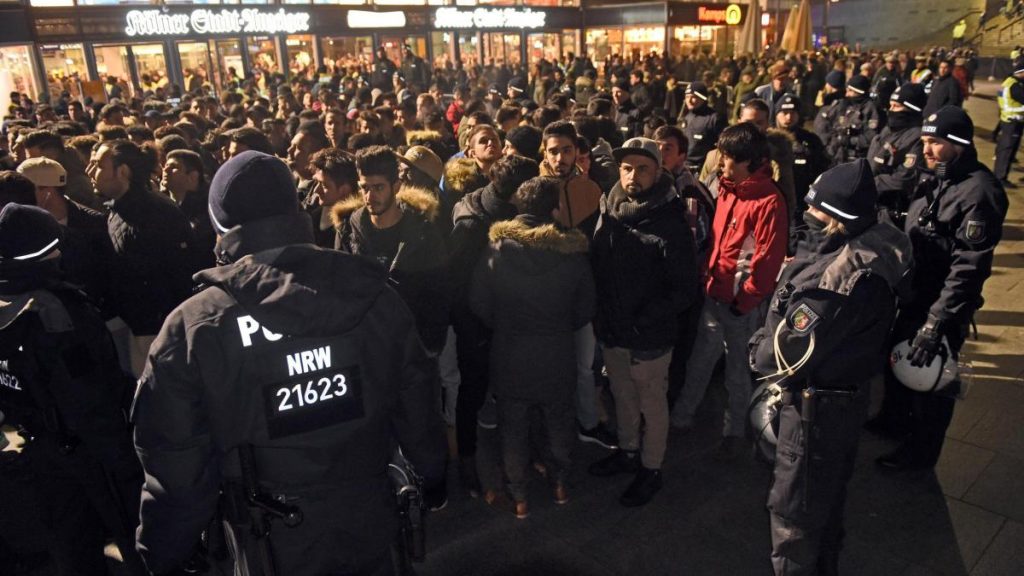
The Police action was successful. The chaotic, aggressive scenes from the previous year could be avoided. Many were relieved – but not everybody:
The Police action against the North Africans was criticized in social networks as “racial profiling” (police action based solely on ethnicity). The leader of the Greens Party, Simone Peter said … that the police action has clearly limited the attacks, “However, the question of proportionality and legality arises when a total of just under 1000 people have been screened solely for their appearance or held in custody.”
One has to admit, though, that other high ranking Green Party members, like Katrin Göring-Eckardt approved of the actions of the Police. The “diversity” practiced the year before in Cologne was probably too much even for this Green politician who is otherwise always in total support of mass migration.
Blaming the Police for harshness
Sometimes the Police has to shoot at a migrant who threatens the life of people in the public. Occasionally this results in the migrant being killed.
You would be forgiven if you thought that even supporters of mass migration, though sad about the loss of life, would congratulate the police for having saved lives. Alas, what typically happens instead is that the police is blamed for having acted too harshly. This is from an article in a German regional newspaper, from August 2019:
The public prosecutor’s office in Stade is examining the circumstances of the shooting of a 20-year-old by a police officer.
The young man attacked policemen with a steel bar on Saturday in the Stader district Bützfleth in a refugee shelter. After the use of pepper spray was unsuccessful, one of the officers shot at the man to stop the attack. The 20-year-old died shortly after of his injuries.
According to information from the “Stader Tageblatt”, the person killed had already been hospitalized due to his psychological problems but was released from medical treatment. The 20-year-old Afghan was considered traumatized.
This was the reaction to the shooting by the police of the Afghan refugee:
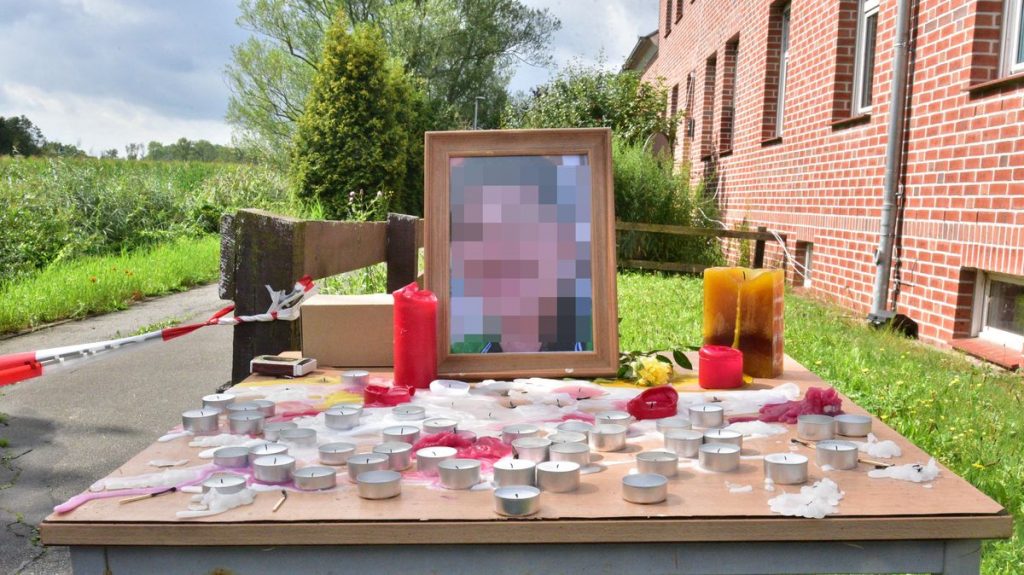
An alliance of Refugee Council, Citizens’ Initiative Human Dignity, Alliance 90 / The Greens and other actors call to commemorate the 19-year-old asylum seeker from Afghanistan, who was killed in a police operation in Bützfleth in August.
“No Forgiveness – No Forgetting” is on the posters that have been hung in Stade … [A poster shows] a crossed-over picture of a police officer in full gear, who is prepared to shoot.
In another incident, also in 2016, Riaz Khan Ahmadzai, a (supposedly) 17-year-old refugee from Afghanistan who arrived in Germany in 2015,
attacked travelers in a regional train near Würzburg on Monday evening with an ax and a knife. Five people – including a tourist family from Hong Kong – were injured, some of them critically, one person lightly.
After an emergency stop of the the train he fled on foot. He injured a passerby – but was then stopped by the police and died “through several shots” of a special task force, as the police said. The teenager tried to attack the officers before the shots were delivered.

Renate Künast, a Member of the German Federal Parliament for the Green Party, reacted to the death of the attacker on Twitter like this:
Why wasn’t it possible to shoot the attacker to be incapacitated only???? Questions!
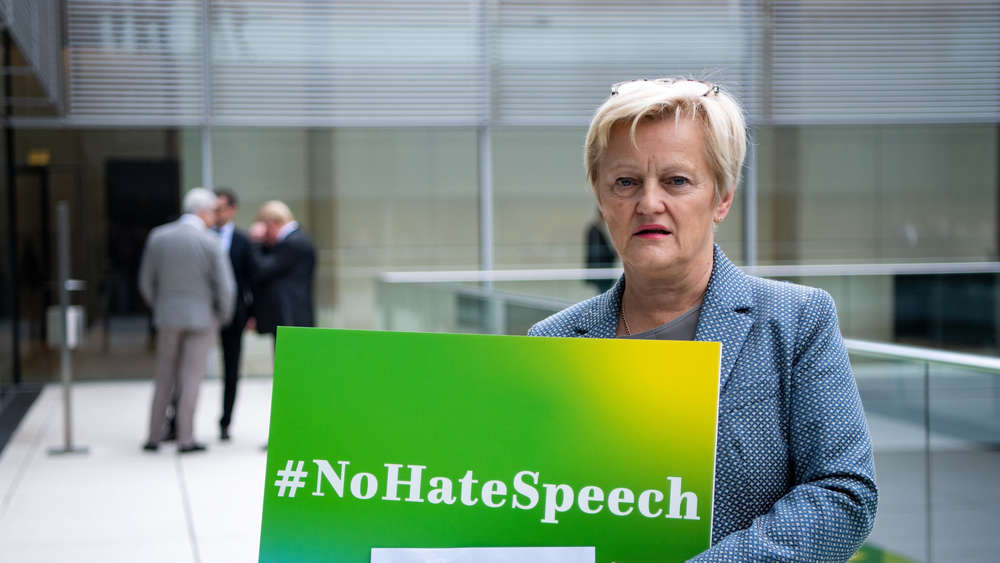
At first there was an attempt by the state prosecutor and media to explain the attack by saying that the attacker wanted to “revenge the death of a friend in Afghanistan”. Reading about this in an article one almost feels sorry for the attacker: none of the commentary dripping from hatred against the perpetrator (and everybody on “the Right”) that one sees when the media reports about far-right terrorist attacks, like the one in Halle, Germany, in October 2019. A few weeks later it became clear that the Afghan attacker was a jihadist and acted on instructions from the Islamic State (ISIS).
Some people have had enough – and speak out
The deflections, blaming of society, blaming oneself when confronted with crimes of refugees – all these lies and self-lies are rampant among left-wing supporters of mass migration. But recently there are more and more courageous people who, in spite of negative consequences for themselves, speak out, even in politically highly correct Sweden. Here are two examples:
Ambulance drivers about the dangers of working in “no-go zones”
In the video below, representatives of the Swedish ambulance driver union describe how they requested military style equipment to protect themselves in no-go zones where they are regularly attacked, often by groups of people.
A Swedish policeman speaks out
Peter Springare, a policeman in Örebro, posted this in Facebook in February 2017:
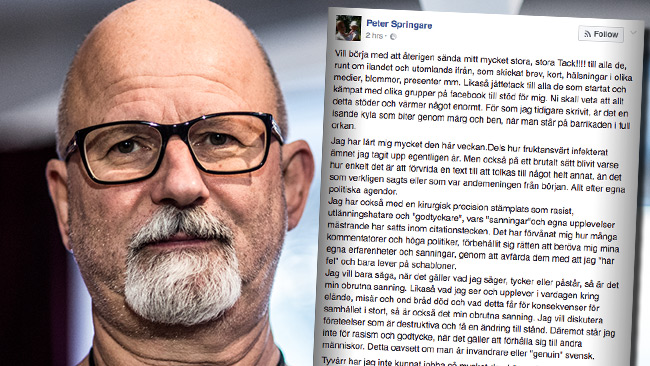
I’m so damn tired. What I will write below is not politically correct. But I shit at that. What I will tell to you, all taxpayers, is not allowed to tell for us government employees. It results in failed careers and losing salary. Although that is true. I shit at all this, I will soon retire after 47 years in this business. I will now and every week in the future give a detailed account of what occupies me as an investigator at the serious crime police in Örebro. It will not be in agreement with the opinion of the National Council for Crime Prevention (BRÅ) or that of other left-wing criminologists in the general debate.
Our pensioners are on their knees, the school is a single chaos, the health care is an inferno, the police have totally failed etc etc. Everyone knows why but no one dares or wants to name the reason, because Sweden has always lived on the myth of the magnificent ultimate society that has senseless resources to be at the forefront of being the only politically correct alternative in a dysfunctional world that knots on itself, through destructive behavior in the name of different religions.
Here we go; This I dealt with Monday – Friday this week: Rape, rape, gross rape, assault rape, extortion, extortion, abuse in court, illegal threats, violence against police, threats against police, drug crime, serious drug crime, murder, rape, murder, murder again and abuse.
Suspected offenders; Ali Mohamad, Mahmod, Mohammed, Mohammed Ali, again, again, again Christoffer … huh it is true. Yes a Swedish name crept onto the edge of a drug crime, Mohammed, Mahmod Ali, again and again.
Countries representing all week’s crimes: Iraq, Iraq, Turkey, Syria, Afghanistan, Somalia, Somalia, Syria again, Somalia, unknown country, unknown country, Sweden. Half of the suspects we cannot know for sure because they have no valid papers. Which in itself usually means that they are lying about nationality and identity.
Now we just talk about Örebro municipality. And these crimes take 100% of our investigative ability.
This is how it looks and has looked for the last 10-15 years.
Will return next Friday with an account of the past week
This was a huge bomb shell in politically correct Sweden. Large numbers of people expressed solidarity with the policeman. There were 13,000 comments under his Facebook post. It was shared 20,000 times, and it was “like”-d more than 43,000 times. The picture below shows some of the flowers that Peter Springare received from the population within a few days after his Facebook post:

Peter Springare did return the following week and continued speaking openly on Facebook. But by that time Swedish media and the Swedish Government became aware of his posting. Immediately, an investigation was started against him at the Police for “agitation against an ethnic group” and even Swedish Prime Minister Stefan Löfven spoke up, criticizing him:
“I don’t know how it looks in Örebro, but from a broader perspective I find it very difficult to see that one hundred percent of police resources are taken up by crimes which are committed by immigrants. I have a very, very hard time accepting that picture, I want to state that it is wrong,” he told the newspaper Expressen.
Löfven’s tactics was transparent: focusing on the “100%” in the policeman’s Facebook post – an easy target, as it was clearly an exaggeration by Springare – and thus diverting attention away from the rest of his post. However, it was also clear from Springare’s post that the “100%” was not much of an exaggeration: he would have been correct if he had written “almost 100%” of the crimes that he was dealing with were committed by immigrants – of a Muslim background.
The investigation was closed without condemning Mr. Springare and the furore around him slowly died down. But the episode showed how fed up many people in Sweden are about the problems caused by mass immigration into their country.
Conclusion
The above can give quite a sobering reading. There is a large over-representation of refugees in crimes, in particular in violent crimes. New types of crimes have been introduced in Europe. Courts and police forces are over-burdened trying to deal with many crimes committed by migrants. Religious extremists require a large security apparatus to keep them under observation and control.
Many migrant criminals are genuinely bad people with psychopathic tendencies – like criminals often are. But many others are probably more or less normal representatives of their culture who become criminals because of various reasons like:
- Culture shock – women who walk around in the streets unaccompanied by men and unveiled, are seen as whores whose violation is not seen as a crime
- Attitudes of migrants towards women clash with Western attitudes. For example, women are not supposed to break up a relationship.
- No connection to the country that took them in – thus decreased inhibition to commit crime
- Many of the refugees are young men – which is the most criminality-prone demographics in any society
- Higher level of aggressiveness than the European average and a discovery that aggressive behavior pays against Europeans who are nowadays much less used to resolving conflicts via aggression
- They discover that the police and judiciary can be very lenient – often even after many crimes committed, there is no jail sentence. This leads to a decreased threshold to commit crime
Thus, we think that the left-wing relativizers of refugee crime are in some sense correct. The main culprits are often not these refugees, in some cases they really don’t know better.
But, while supporters of mass migration blame European society for the crimes of the refugees because it supposedly refuses to give them enough support, is too xenophobic, racist, etc., we think that the real culprits are those – politicians, journalists, academicians – who support the entry of these people in large numbers into European countries, and who, when inevitable problems occur, try to deflect the debate away from these problems, lie about them and try to sweep them under the carpet.
To be continued
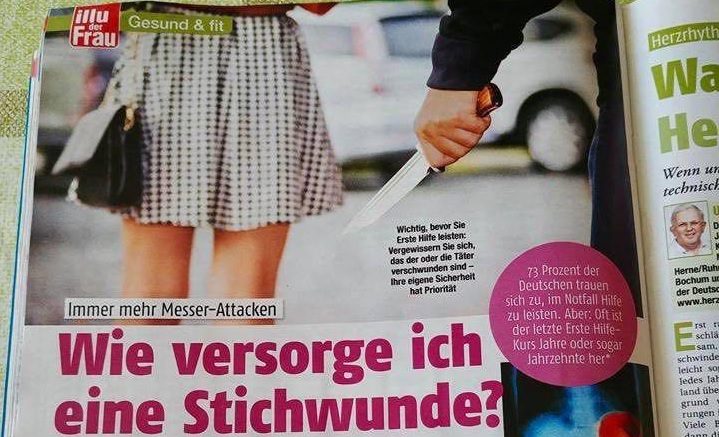
Be the first to comment on "The Great Replacement: Myth, conspiracy theory, or reality? Part 5: “Diffused fears only”"